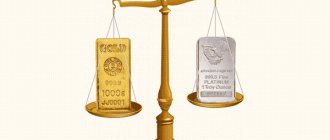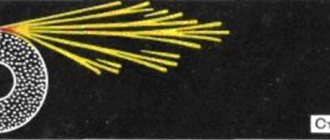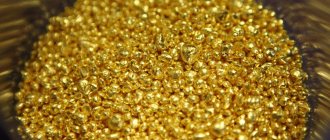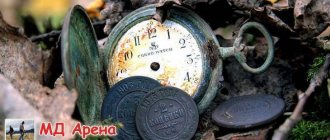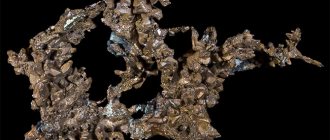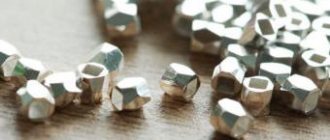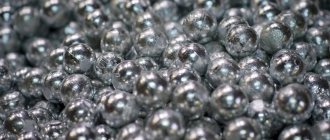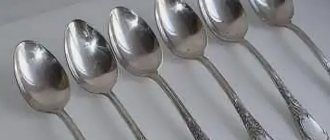Copper has a bright red tint, unlike brass.
Copper is a metal obtained by processing ore. A distinctive feature of copper is its color - reddish, brown in places, and pink at the break. This metal belongs to the non-ferrous group, which includes almost all substances, with the exception of iron and its alloys, which form the group of ferrous metals. The properties of copper - photos, descriptions and the extraction process will be discussed below.
How to distinguish copper from other metals
For most of us, knowledge about copper and its properties is limited to a school chemistry course, which is quite enough at the everyday level. However, sometimes there is a need to reliably determine whether a material is a pure element, an alloy, or even a composite material. The opinion that this information is needed only by those who are engaged in the acceptance or delivery of scrap metal is erroneous: for example, on amateur radio forums, topics are often raised about how to distinguish copper in wires from copper-plated aluminum.
Pinchbeck - gold substitute
In 1720, Christopher Pinchbeck (1670-1732) invented an alloy made of copper and zinc as a cheap substitute for gold. He called it by his name.
Pinchbeck typically contains copper and zinc. Jewelry alloy works well and looks like gold, but is lighter. It is believed that the inventor had a secret that allowed the products not to lose their shine. The Pinchbeck family produced not only jewelry and watches from the invented alloy. The advertisements included swords, tweezers, snuff boxes, forks, spoons, buttons, belt buckles and much more.
Briefly about element No. 29
Pure copper (Cu) is a golden-pink metal with high ductility, thermal and electrical conductivity. Chemical inertness in an ordinary non-aggressive environment is ensured by a thin oxide film, which gives the metal an intense reddish tint.
The main difference between copper and other metals is color.
. In fact, there are not so many colored metals: only gold, cesium and osmium are similar in appearance, and all elements included in the group of non-ferrous metals (iron, tin, lead, aluminum, zinc, magnesium and nickel) have a gray color with varying intensity of shine.
An absolute guarantee of the chemical composition of any material can be obtained only through spectral analysis. The equipment for carrying it out is very expensive, and even many expert laboratories can only dream of it. However, there are many ways to distinguish copper at home.
with a high degree of probability.
Roofing coverings
The original color inherent in copper, as well as its anti-corrosion properties, played a big role in its development as a roofing material many years ago. For a long time, cheaper steel and aluminum were used in this capacity, but recently designers and architects have again become interested in the unusual metal.
Copper roofing is distinguished not only by its luxury and attractiveness, but also by its high quality and long service life, its ability to withstand various influences: mechanical, temperature and others. Houses with copper roofing have a stylish and presentable appearance.
Thanks to technological capabilities, it is now possible to immediately obtain copper of the desired color ; previously, houses were covered with shiny yellow scrap metal. Over time, the color of the roof gradually darkened as metal oxide formed on its surface. And over time, chemical processes that occurred under the influence of the environment formed a layer of malachite-green patina on the roof. Thanks to this layer, the metal is reliably protected from the corrosion process, so roofs covered with patina last for several decades and at the same time retain their performance characteristics.
Currently, specialized stores are equipped with many catalogs where you can immediately select copper sheets of a suitable color to cover the roof. Thanks to modern technologies, you can choose between classic, oxidized and patinated coating types.
Nowadays copper is used not only for the roofs of houses, but also for facades. This is both beautiful and profitable. The copper facade does not require special care, does not fade in the sun, and protects the building from temperature changes and high humidity.
The originality of the color is distinguished by copper oxide and sulfate, which are widely used in industry. Copper oxide, which has black crystals, is used to tint glass and paint materials. Copper sulfate is not used as a dye, but it has a wonderful blue-turquoise color.
Source
Determination by color
So, we have before us a piece of unknown material that needs to be identified as copper. The emphasis on the term “material” rather than “metal” was made specifically, since recently many composites have appeared that are very similar to metals in appearance and tactile sensations.
First of all, we consider color. It is advisable to do this in daylight or “warm” LED lighting (under “cool” LEDs, the reddish tint changes to yellow-green). It is ideal if there is a copper plate or wire for comparison - in this case, errors in color perception are practically eliminated.
Important: old copper products can be covered with an oxidized layer (a greenish-blue loose coating): in this case, the color of the metal must be looked at in a cut or saw cut.
Mining process
Currently, copper-containing ore is mined in several countries; the most significant deposits are recorded in Chile, the USA, Australia, Canada, and Indonesia. The process of extraction of this mineral does not stop, although in recent years it has noticeably decreased.
Copper is mined from ore
The decrease in production volumes is due to the widespread use of scrap in production, that is, raw materials obtained as a result of several processing cycles. Copper is a fairly durable metal and does not lose its physical and chemical properties over time. Therefore, its life cycle is quite long, but products made from it often become unusable due to physical or moral wear and tear. Therefore, the owners hand them over to scrap metal collection points. This cyclical processing process has a beneficial effect on the environmental component of any production. Firstly, the bowels of the earth are preserved, and secondly, a large amount of energy is spent when processing ore, and 90% less when processing scrap. This is a very high indicator, which not all metals have.
Copper, brass and gold have different shades
It is clear that the question “is copper a non-ferrous metal or a ferrous metal?” you can give a completely unambiguous answer - colored, even the ore in its original state has a pronounced copper color. Ore is mined mainly by open-pit mining, that is, without constructing mines, and the metal itself is obtained by beneficiation using the flotation method. This method involves wetting the ore rock with water; substances that do not contain metal get wet and stick together, forming waste, and unwetted particles rise up with the air flow, forming foam. Next, the foamed ore undergoes an additional purification cycle, and then is sent to the furnace for smelting and forming blanks.
Determination by magnet
Color matching is a reliable but not sufficient method of identification. The second step of independent experiments will be a test with a magnet. Chemically pure copper is classified as diamagnetic - i.e. to substances that do not respond to magnetic influence. If the material under study is attracted to a magnet, then it is an alloy in which the content of the main substance is no more than 50%. However, even if the sample did not react to the magnet, it is too early to rejoice, since often an aluminum base is hidden under the copper coating, which is also not magnetic (this can be eliminated by filing or cutting).
White copper is an alloy of copper with
White copper - Arch. Nickel plated metal. AOS 1, 159 ... Large dictionary of Russian sayings
COPPER - White copper. Arch. Nickel plated metal. AOS 1, 159. Ringing copper. Book 1. Something big and loud, but essentially empty and barren. 2. About lush, but little content words. /em> Expression from the First Epistle of the Apostle Paul to the Corinthians.... ... Large dictionary of Russian sayings
Nickel - I (technical) Ores containing nickel in sufficient quantities for its extraction can be divided into two groups: a) ores that, in addition to nickel, iron and sulfur, contain cobalt, arsenic and antimony, and b) ores , which do not contain the latter impurities. The first of... ... Encyclopedic Dictionary F.A. Brockhaus and I.A. Ephron
Argentan - or nickel silver (also cupronickel, new silver) has long been known among the Chinese under the name pack fong, which means white copper; among the French it is called maillechort or argent d Allemagne, among the Germans Argentan or Neusilber, and among the English German silver. A.... ... Encyclopedic Dictionary F.A. Brockhaus and I.A. Ephron
Cupronickel (alloy) - This term has other meanings, see Cupronickel. Five Swiss francs Cupronickel (corrupted from the French Maillot Chorier) is an alloy of copper and nickel, sometimes with the addition of iron and manganese. Cupronickel usually contains 5 ... Wikipedia
Zanskar is a historical region and tehsil of Kargil district located in the state of Jammu and Kashmir. Padum Center. Zanskar, as well as Ladakh, were in the sphere of influence of the Western Tibetan kingdom of Guge. Zanskar Range ... Wikipedia
Determination through chemical experiments
The reaction with concentrated nitric acid is indicative: if the latter is dropped onto the surface of a copper product, a green-blue color will occur.
A qualitative reaction to copper is dissolution in hydrochloric acid followed by exposure to ammonia. If a copper sample is left in an HCl solution until completely or partially dissolved, and then ordinary pharmaceutical ammonia is dropped into it, the solution will turn intensely blue.
Important: working with chemicals requires precautions. Independent experiments should be carried out in a well-ventilated area using personal protective equipment (rubber gloves, apron, goggles).
News & Events
According to White House economic adviser Larry Kudlow, the obstacle was that China refused to legislate.
The copper contract for delivery in 3 months retreated below $5,800 per ton, to $5,791 per ton (-1.5%) in the wake of active sales. By the end of the auction, 17,000 lots of metal had been sold.
5 per ton, zinc – $2797 per ton (including 17% VAT); at NYMEX (delivery July 2022): copper – $5905 per ton; on NYMEX (delivery October 2019): copper – $5938 per ton.
The copper contract for December delivery settled at 46,930 yuan ($6,591) per tonne, up 230 yuan (0.5%) from Thursday's total.
How to distinguish between copper and its alloys?
Copper alloys are widely used in industry. Over many years of research, it has been possible to obtain many materials with unique properties: high ductility, electrical conductivity, chemical resistance, strength (all depends on alloying additives). The most common are bronze (with the addition of tin, aluminum, silicon, manganese, lead and beryllium), brass (with the addition of 10-45% zinc), as well as copper-nickel alloys (nickel silver, cupronickel, copel, manganin).
Only bronze and brass are difficult to identify, since copper-nickel alloys differ significantly in color due to their low copper content.
Copper or brass?
Brass can contain from 10 to 45% zinc, a silver-gray metal. Naturally, the more zinc, the paler the alloy. However, high-copper brasses, in which the amount of additives does not exceed 10%, differ little in color from the copper sample. In this case, you can only trust your feelings: brass is much harder and more difficult to bend (for greater reliability, a comparison with a reference sample is advisable). You can try to remove the shavings: copper shavings will have a curl shape, brass shavings will be straight, needle-shaped. When the samples are placed in a solution of hydrochloric acid, no reaction with copper is observed, and a white coating of zinc chloride forms on the surface of the brass.
Copper or bronze?
Like brass, bronze is much stronger, which is explained by the presence of harder metals in the alloy. The most reliable test will be a “tooth test” - there is unlikely to be a trace of pressure left on the surface of the bronze.
You can also experiment with a hot saline solution (200 g of table salt per 1 liter of water). After 10-15 minutes, a copper sample will acquire a more intense shade than a bronze one.
Tompak, aka copper alloy
Tompak (French tombac) is a copper alloy with a low zinc content (3-20%). Tompak is classified as brass; sometimes brass is called tombak and vice versa. They are similar in composition and hardly differ in appearance. Tompak, like copper, is easily processed and darkens in air. Well coated with enamel or gold plated. Therefore, it was used to make dishes, badges, orders and awards. They made mechanisms and chains for watches. Because of its reddish-yellow color, it was used in costume jewelry to imitate gold. The best example of a tombak product is antique Czech brooches with pyropes.
For those familiar with electrical engineering
Very often, copper cores from electrical cables are sold as scrap non-ferrous metals, and there are often cases when copper-coated aluminum is used in the production of electrical products. This material has a significantly lower density, but due to its irregular geometric shape, determining the volume to calculate the density is quite difficult. In this case, copper can be determined by electrical resistance (of course, if you have the appropriate instruments - a voltmeter, ammeter, rheostat). We measure the cross-section and length of the core, take instrument readings, and Ohm’s law will help you. Resistivity is a fairly accurate characteristic by which any metal can be identified with a high degree of reliability.
Copper roofing
The beautiful color that is characteristic of copper (see photo), as well as its exceptional corrosion resistance, was the reason that many years ago it began to be used as a roofing material. For a long time, copper in this capacity was inferior to cheaper steel and aluminum, but now architects and designers have again paid attention to this unique metal in all respects.
A copper roof with a luxurious color not only looks attractive from an aesthetic point of view and can serve its owners for decades, but is also able to successfully withstand significant mechanical, temperature and any other influences. Houses covered with roofing made of this metal look stylish and presentable.
Copper roofing
Does yellow copper exist?
Having started talking about iron, steel and cast iron, we completely forgot about copper pans.
Some pots are made of red copper. One could simply say - from copper, because there is no other, not red, copper. They also often talk about yellow copper. But yellow copper is not copper at all, but brass - an alloy of copper and zinc, the same brass from which door handles are made. Brass contains only half of copper, at least not more than two-thirds. The more zinc in brass, the lighter it is. If there is more than half zinc, the brass becomes almost white. This, then, is a simple way to determine by color whether there is a lot of zinc in brass.
The pots in question are very fond of cleanliness and neatness. If you don't clean them, they will soon become covered with a brown or green coating.
Primary color and shades of copper
From the school chemistry course, we all know well that copper is red in color, and if you look closely at the fracture of this metal, you can see that inside it has a pinkish tint. The beautiful color of the surface is not the only advantage of this metal, which modern industry produces in several grades (M00, M0, M1, M2, M3). Copper, used by mankind since ancient times, is characterized by a fairly high density, low resistivity, and exceptional electrical and thermal conductivity.
Learning to identify copper and distinguish it from other metals and alloys
Chemically pure copper has three distinctive characteristics. It is a colourful, ductile and corrosion resistant metal. The latter property is due to the formation of a thin oxide film. This layer makes the copper chemically inert in a non-corrosive environment and also adds a red tint to its golden pink color.
The best way to accurately identify copper is spectral analysis, which requires expensive equipment - a metal analyzer, while identifying copper at home is a task with a limited set of tools. Here the best instruments are the senses, easily accessible chemicals, fire and improvised devices.
Tin is the purest metal
Tin has been known to man since the 4th millennium BC. Coins were minted from it and vessels were made. In ancient Rus', churches, doors and iconostases were decorated with openwork tin casting.
Tin is silvery-white in color, but darker than silver. This is the purest metal and does not rust. Tin utensils are highly valued - they do not in any way affect the taste and smell of food. Soft, tough metal. Does not oxidize in air and very slowly in water.
Tin Plague
Tin is resistant to corrosion, but when strongly cooled, it loses its metallic properties. Individual gray spots appear on the product. With further cooling they spread over the entire surface. The transformation of tin into powder is called the “tin plague.” «
. You can stop it by heating it to +18 °C.
When exposed to air, tin fades beautifully. This velvet shade is highly prized by collectors. Tin is not dishwasher safe and is best polished. Utensils for eating must be marked 95%. But it is worth considering that tin melts at a temperature of 170-230 °C.
Applications of tin
Currently, pure tin is not used. It is used for alloys with copper and lead. Also obtained from tin «
gold leaf
"
in the form of thin leaves or powder. This is tin disulfide, a shiny mass. Durable and gold-like in color. Retains shine on products indoors and outdoors for a long time. (A. V. Flerov “Materials science and technology of artistic processing of metals.”)
How to distinguish copper from other metals by eye?
Visual perception is the simplest, but not always quite accurate method. However, in most cases it works and it is not difficult to distinguish copper scrap from other non-ferrous metal scrap. Indeed, despite the name of the category non-ferrous metals, only the following are equally colored:
The remaining metals are characterized by a gray tonality and differ mainly in the intensity of their shine. Therefore, color is an excellent “means of identification” in such matters as distinguishing copper from aluminum, zinc or nickel.
Pure copper with a characteristic copper color
The natural color of the pure element Cu is red-pink. It is recommended to look at metal in natural light. Artificial lighting, with the exception of LED lamps with warm color temperatures, changes the hue towards a yellow-green tone.
The second rule for visual identification of copper is that the surface oxide film must be removed. Oxidation creates a greenish-blue coating on the metal surface. Therefore, to determine by color that you have copper, preferably by fresh sawing or by processing the material with a file. The situation with copper alloys: brass and bronze is much more complicated. It is also visually difficult to distinguish between Cu and copper-plated aluminum.
Silver is the favorite metal of jewelers
Silver has been known to man since the 5th century. BC, but “younger” than gold. Prehistoric Sardinia is considered the birthplace of silver. In Assyria and Babylon, silver was a symbol of the Moon and was considered sacred. In the Middle Ages it was popular among alchemists.
This is a precious metal with a white, shiny color. Occurs in nature in the form of ore or native state. Silver is harder than gold and softer than copper. Very ductile and easily rolled into thin sheets and wire. It cuts and polishes well. Silver does not oxidize in air or when heated. But it darkens under the influence of sulfur or hydrogen sulfide, which are present in the air and the human body. The higher the silver standard, the less oxidation .
In humid climates or indoors, metal darkens faster.
Features of silver
A special property of silver is its sonority. The purity of the ringing of church bells and instrument strings is achieved by adding silver. The thinnest layer of silver is applied to the surface of the mirrors. This is a material for jewelry, dishes and cutlery. For filigree production and enamel products. Silver can also be contained in gold and platinum
alloys, making them lighter. Used for soldering copper and brass products.
Silver is not affected by boiling caustic alkalis. It dissolves in nitric and hot sulfuric acid.
How to distinguish copper from brass and bronze
The first metal is a Cu-Zn alloy. The zinc content varies in the range of 4 – 45%. When an alloy is characterized by a high addition of a major impurity, it is easy to distinguish it from pure metal by color. The color of copper is pink-red, brass is lighter, but scrap brass may have a dirty surface. The more zinc in the alloy, the more its color shifts from red to yellow. Therefore, visual perception is unacceptable for high-copper brasses, where the presence of impurities is at the level of 10%. In this case, there are 3 options left for how to distinguish copper from brass without using a tool:
- By sound. It is advisable to have an ear for music here. When struck against metal, soft copper sounds muffled, while brass sounds loud. The method works well for massive, oversized products - pipes, for example.
- Along the fold. The ductility of copper allows the metal to be easily bent. Harder brass is not as malleable.
- By weight. The density of Cu9 g/cc is higher than that of Zn (7.1). The resulting characteristic value for brass is on average 8.6 g/cc. The difference is small, but if you have accurate scales, it is possible to distinguish metals.
Popularity of the pinchbeck
Pinchbeck jewelry became popular in the 18th century. They were bought by the middle strata of the population. The alloy was also used for decorations in theatrical productions.
Wealthy travelers wore pinchbeck items to protect themselves from road robbery. Sometimes the jewelry was copies of family jewelry. Sometimes they acted as independent objects and in appearance were in no way inferior to the insanely expensive ones. And it was indecent for noble persons not to decorate themselves when traveling.
At the beginning of the 19th century. pinchbeck jewelry began to be passed off as gold. It was then that the fame of “fake gold” was established.
In the 1830-1840s, the pinchback was even counterfeited, but was hardly used after 1854, when the ban on the use of low-grade gold was lifted. Later, methods of applying gold plating to base metals completely replaced the pinchbeck.
How to distinguish copper from bronze
It is not always possible to determine which metal is in front of you by color. Bronze is an alloy of copper and tin, also characterized by a pink-red hue; scrap bronze can be found in anything. In this case, the main distinguishing characteristic is the ductility of the pure metal. By pressing on the copper with a hard object, we get a notch on the surface. Deforming bronze is much more difficult.
Items made of bronze are very difficult to distinguish visually from copper
An alternative way to distinguish copper from bronze at home is a saline solution. Add 200 grams of table salt to a metal container containing 1 liter of water. The solution is heated to a temperature above 50 °C. Next, the metal is placed in the heated liquid and kept for about 15 minutes. The color of copper changes. Bronze remains insensitive to the effects of saline solution.
The next method is patination of copper. Oxidation of pure metal over time in air is an inevitable process, leading to the formation of a greenish-blue coating. Bronze is not subject to patination.
Main characteristics
The main quality of copper wires is good conductivity of electric current.
A special feature of this metal is its ability to conduct electric current; according to this indicator, copper is in second place after silver. This ability is most fully manifested in copper in its pure form, without impurities, since any addition of various substances to the composition will reduce conductivity. Copper is characterized by high strength and durability, so it is often used for the manufacture of pipes and roofing materials. Due to the beautiful color of copper and its shine, it is widely used for making dishes, decorative elements, and interior items.
Silver has a higher percentage of conductivity but is more expensive
An important characteristic of copper is the oxidation process. When exposed to a humid environment for a long time, the metal becomes covered with a unique coating. Its peculiarity lies in the fact that it is this layer of patina (as the oxidized layer is called) that protects the metal from corrosion, fractures and other types of damage. Some artists and sculptors artificially expose copper to moisture to obtain the original color of the product. Here the question appropriately arises: what color is copper after oxidation? The most striking example of oxidized metal is the Statue of Liberty in America. Years after its construction, a patina began to appear - the green color gradually covered the entire monument, and the Americans began to call their symbol the “Green Lady”.
To increase the metal's resistance to corrosion, lead is added to its composition, and the resulting alloy is bronze. It has a darker color, rich red-brown and improved qualities - strength, elasticity, resistivity.
Another important characteristic of copper products is high energy efficiency. Due to the thermal conductivity and other properties of the metal, its use is indispensable in renewable energy sources and contributes to significant energy savings. If insulated copper pipes are used in heating systems, heat losses are reduced several times. On the other hand, when such pipes are used in cooling systems, the set temperature is also maintained; they remain cold longer. As a result, energy costs are reduced, emissions of harmful substances into the surrounding atmosphere are reduced, and the environmental situation in the region improves.
Gold is the most expensive electrical conductor
Copper is an essential trace element necessary for the functioning of the human body; it is found in many foods, for example, whole grains, nuts, potatoes, and legumes. This microelement is necessary for the formation of blood cells, for better absorption of iron, affects the metabolism of sugar and cholesterol, and has a beneficial effect on cardiac function and brain function. The daily requirement for copper for an adult is from 1.5 to 3 mg, while its deficiency has a more detrimental effect on the body than excess.
Everyone has come across copper metal at least once in their lives and can imagine what it looks like, since it surrounds us in many everyday things, in addition, the Internet is full of information and finding out what copper looks like in a photo is now not difficult.
How to distinguish copper from aluminum
Naturally, metals are easy to distinguish by color. The situation becomes more complicated when it is necessary to determine what the cable cores are made of. Tinned copper takes on a silvery tint, while copper-plated aluminum takes on a yellow tint. The result is that it is extremely difficult to distinguish metals from each other by color.
The best option is to measure the resistance. For a copper twisted pair cable about 100 meters long, the parameter value reaches 4–8 ohms. The resistance of a similar aluminum cable is significantly higher: 12 – 20 Ohms. This method is good because there is no mechanical impact on the metal.
The second method is bending/extension of the vein. The aluminum conductor will break quickly. The next option is a flame test. The melting point of aluminum is 600 °C, that of copper is much higher.
Analytics and reviews
The copper market looks more interesting. In fact, the figures given take into account the recycling of scrap by the largest manufacturers. According to the Ministry of Natural Resources, 850 thousand tons of copper are mined in the country, and only key ones are smelted.
China Moly has become the world's second largest cobalt producer, and in copper production the company has also gradually moved closer to leading producers.
Bismuth (Bi), a brittle white metal with a pinkish tint and beautiful shimmering oxide film, actually existed.
Other cases of fire and acid testing
Exposure to flame is used not only to identify metal relative to aluminum. For these purposes, a gas stove, lighter or fire is sufficient. Heating copper leads to the formation of its oxide, which affects the color change. The surface of the metal gradually becomes dull until it acquires a completely dark shade.
Nitric acid is another identifier for copper at home. It is also important to be careful here. It's better to just drip the liquid onto the metal. Pure copper at the point of contact will turn blue-green.
Video - how to distinguish aluminum from copper:
Richness of primary color and variety of shades
Until recently, technological capabilities did not make it possible to immediately obtain copper of the desired color and the roofs of houses were covered with the classic yellow-shiny metal. Over time, as metal oxide formed on the surface of the metal, the roof took on a darker hue. Further chemical processes occurring in copper, which actively interacted with the environment, led to the formation of a layer of malachite-green patina on its surface.
Patina, along with the painting of roofs, reliably protects them from corrosion. Copper roofs covered with such a film can last for decades without losing their performance characteristics.
Nowadays, using photos in the catalogs of specialized stores, you can immediately choose what color copper sheets to use to cover the roof of your house. The capabilities of modern technologies make it possible to immediately obtain classic, oxidized or patinated copper.
Nowadays, not only the roofs of houses, but also their facades are covered with copper of different colors. It should be noted that this is not only beautiful, but also profitable from a financial point of view. The copper sheets with which the facade of the house is finished do not require special care and do not fade over time, reliably protecting building structures from the negative effects of temperature changes and high humidity.
Copper oxide and sulfate, which are actively used in modern industry, also have interesting colors. Copper oxide, whose crystals are black, is used to impart various shades (blue, green) to glass and paints and varnishes. Copper sulfate is not used as a dye, but still has a beautiful blue-turquoise color.
GOSTs, TUs, standards
Key words—ferroboron; copper; photometric method; atomic absorption method. Type of standard - Standards for control methods. Type of requirements - The document is marked * Designation of the replacement(s) - GOST 14021.7-68.
Abstract (scope of application) - This standard establishes photometric and atomic absorption methods for the determination of copper in ferrovanadium at a mass fraction of 0.01 to 0.6% Key words - ferroalloys; analysis.
Key words - ferromolybdenum; determination of copper; photometric method; atomic absorption method; equipment; reagents; solutions; processing of results. Type of standard - Standards for control methods. Designation of the replacement(s) - GOST 13151.7-77.
Key words - chromium metal; methods for determining copper; photometric method; atomic absorption method; methods for determining copper; metallurgy; chemical analysis of chromium. Type of standard - Standards for control methods.
. non-ferrous metals (aluminum, copper, titanium and their alloys) used in chemical, petrochemical, oil refining and related industries, operating under conditions of single and multiple loads under internal excess.
Abstract (scope of application) - This standard establishes standards and methods for calculating the strength of vessels and apparatus made of carbon and alloy steels, non-ferrous metals (aluminum, copper, titanium and their alloys) used in the chemical industry.
Source: www.metaltorg.ru
ORIGIN
Small nugget of copper
Typically, native copper is formed in the oxidation zone of some copper sulfide deposits in association with calcite, native silver, cuprite, malachite, azurite, brochantite and other minerals. The masses of individual clusters of native copper reach 400 tons. Large industrial deposits of native copper, along with other copper-containing minerals, are formed when volcanic rocks (diabases, melaphyres) are exposed to hydrothermal solutions, volcanic vapors and gases enriched in volatile copper compounds (for example, the Lake Superior deposit, USA). Native copper is also found in sedimentary rocks, mainly in cuprous sandstones and shales. The most famous deposits of native copper are the Turin mines (Urals), Dzhezkazgan (Kazakhstan), in the USA (on the Keweenaw Peninsula, in the states of Arizona and Utah).
Who suits copper hair color?
Copper gives the most natural red color. It suits most women. The main thing is to choose the right shade. Copper harmonizes with milky skin and warm-colored eyes (brown, olive, green). This look is considered a classic, but this does not mean that blue-eyed women should not wear red hair.
Those with pale blue eyes need to choose the shade carefully. Bright red curls will distract attention from the face.
The choice of shade is based on skin condition and color type. It is better to consult a colorist. The master will tell you how to smooth out imperfections and highlight beauty.
